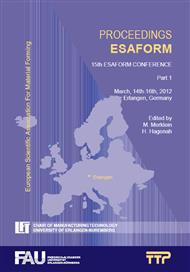p.151
p.157
p.163
p.169
p.175
p.181
p.187
p.193
p.199
Compound Forging of Hybrid Powder-Solid-Parts Made of Steel and Aluminum
Abstract:
Compound forging is a technology to successfully manufacture hybrid parts by applying resource-saving process steps. During compound forging of steel-aluminum parts the formation of intermetallic phases is benefited. The thickness of these intermetallic phases influences the bonding and thus the global part quality. According to literature, specific coating elements reduce the phase seam thickness. In powder-metallurgically manufactured parts it is possible to selectively insert specific elements in the surface area. Therefore, a time intensive coating process can be avoided. The applicability of combining the technologies of powder-metallurgy and compound forging is discussed in this paper. Powder-metallurgically manufactured and solid parts made of steel and aluminum are compound forged and the influences on deformation behavior and the joining zone are investigated.
Info:
Periodical:
Pages:
175-180
Citation:
Online since:
February 2012
Price:
Сopyright:
© 2012 Trans Tech Publications Ltd. All Rights Reserved
Share:
Citation:


